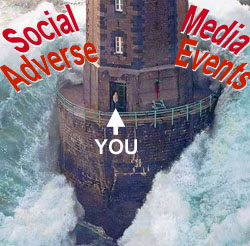Vol. 8, Issue No. 9: OCTOBER 2009 – EXECUTIVE SUMMARYFear and Loathing in Washington, DC Upfront Commentary
 Even before the Federal Register Docket was open for comments, I sent a snail mail letter to FDA requesting a seat at the upcoming November public hearing on social media.
Even before the Federal Register Docket was open for comments, I sent a snail mail letter to FDA requesting a seat at the upcoming November public hearing on social media.
Not only will I have a seat, but I will make a presentation and have my 15 minutes of fame (literally!) in front of the DDMAC luminaries and the audience stuffed in the 350-seat meeting room at the National Transportation Safety Board (NTSB) Conference Center.
Read this entire OpEd piece by John Mack here:
www.news.pharma-mkting.com/PMNews_89_UpFront.pdf Social Media Adverse Event Reporting Safe Harbors It’s Time for FDA to Open Up the Internet to Rx Advertising Like It Did with TV!
 Adverse event (AE) monitoring and reporting are the two primary hurdles that pharmaceutical marketers must overcome before they can feel comfortable using the full two-way conversational features of the new Internet (ie, Web 2.0, aka “social media”).
Adverse event (AE) monitoring and reporting are the two primary hurdles that pharmaceutical marketers must overcome before they can feel comfortable using the full two-way conversational features of the new Internet (ie, Web 2.0, aka “social media”).
This article presents ideas for regulatory “safe harbors” under which pharma companies would be relieved of the responsibility of monitoring social media for adverse events. Whether or not the FDA implements these or some other form of safe harbor is anybody’s guess. But if the drug industry really wants a safe harbor — and there is some question about that — this could be a start.
As background, the article also includes a detailed summary of responses to the survey “FDA Regulation of Drug & Device Promotion via the Internet & Social Media” regarding social media adverse event monitoring, processing, challenges, and uncertainties.
Topic headings include:
- What Is an Adverse Event?
- FDA Clarifies Pharma’s AE Reporting Responsibilities
- “AEs” Within SM Discussions
- The Adequate Provision Safe Harbor Precedent
- AEs, Internet, & the FDA
- Monitoring Adverse Events
- Processing AEs from Social Media Sources
- Challenges Handling Adverse Events Found on SM Sites
- Uncertainties Regarding Adverse Events Found on SM Sites
- Tit-for-Tat Tithe on Pharma Marketing
- The Adverse Event Reporting Widget Safe Harbor
- There’s Value in Adversity
Read this article now. It’s FREE…
Pharmaceutical Market Access 2010 Strategic Developments Impacting the US, EU, and Emerging Markets
 It’s no secret that the pharmaceutical and biotechnology industries are confronting significant short-term and long-term financial challenges that range from generic competition, upcoming patent expirations, and pending healthcare legislation and reforms in both the US and EU. These challenges are forcing the industry to “rethink” everything from R&D to Marketing.
It’s no secret that the pharmaceutical and biotechnology industries are confronting significant short-term and long-term financial challenges that range from generic competition, upcoming patent expirations, and pending healthcare legislation and reforms in both the US and EU. These challenges are forcing the industry to “rethink” everything from R&D to Marketing.
“Future revenue growth in the US and EU will be limited,” said Stephen Potts, KantarHealth Regional Director, Asia Pacific, the Middle East and Africa, during a recent webinar entitled Pharmaceutical Market Access 2010. “Pharma and biotech companies are looking to emerging market opportunities in Brazil, Russia, India, and China (i.e., BRIC) to drive future business,” said Potts. “The EU is wrestling with the cost effectiveness of treatments and working through key changes in important regulatory processes. In addition, US healthcare reforms and pending legislation are pointing to universal coverage or the emergence of a ‘national plan’.”
What does this all mean for patients, physicians, payers, and pharmaceutical/biotech manufacturers especially as payer actions and priorities converge across borders? Potts and his co-speakers — Lee Blansett, KantarHealth Senior Vice President, Oncology Market Access and Susanne Michel MD, KantarHealth Head of Global Market Access, Pricing and Reimbursement — addressed those questions during the webinar. This article presents a summary of the webinar.
Topic headings include:
- The Shifting Center of World Markets
- Access to Emerging Markets
- Defining Ghostwriting
- Trouble and Turmoil in the US Market
- A Rise in Cost Consciousness
- The UK Side of the Pond
Read this article now. It’s FREE…
Risk Mitigation and Its Impact on Pharma Marketing Appropriate Use Benefits After Launch
 Drug safety has always been a concern of FDA and drug manufacturers. Recently, however, FDA is paying even more attention to drug safety issues. The Food and Drug Administration Amendments Act of 2007 (FDAAA) granted the FDA the authority to require pharmaceutical companies to submit and implement a REMS — Risk Evaluation and Mitigation Strategy — if the FDA determines a REMS is necessary to ensure that a drug’s benefits outweigh its risks. About 33% of new molecular entities approved since FDAAA became effective on March 25, 2008 have required a REMS, and 75% of these required a Medication Guide, which contains information for patients on how to safely use a drug product, with a REMS assessment. So, REMS are becoming more common than in the past, although they are not yet “the rule.”
Drug safety has always been a concern of FDA and drug manufacturers. Recently, however, FDA is paying even more attention to drug safety issues. The Food and Drug Administration Amendments Act of 2007 (FDAAA) granted the FDA the authority to require pharmaceutical companies to submit and implement a REMS — Risk Evaluation and Mitigation Strategy — if the FDA determines a REMS is necessary to ensure that a drug’s benefits outweigh its risks. About 33% of new molecular entities approved since FDAAA became effective on March 25, 2008 have required a REMS, and 75% of these required a Medication Guide, which contains information for patients on how to safely use a drug product, with a REMS assessment. So, REMS are becoming more common than in the past, although they are not yet “the rule.”
“Risk management, REMS, danger management of your product’s life cycle, whatever you call it, all are crucial to brand managers and marketing executives,” said Jeff Fetterman, President and CEO of ParagonRx (www.paragonrx.com), a Delaware-based company which specializes in programs for the appropriate use of medications.
This article summarizes Fetterman’s ideas about how to develop a REMS that can be a win-win-win situation for you, your product, and the patient.
Topic headings include:
- REMS 101
- Balancing Interests
- REMS Program Impact on Intention to Prescribe
- Alignment of Interests
- ParagonRx’s Science-Based Methodology
Read this article now. It’s FREE…



![6 Digital Tools at the Center of Healthcare Digitalization [INFOGRAPHIC]](http://ec2-54-175-84-28.compute-1.amazonaws.com/pharma-mkting.com/wp-content/uploads/2021/04/6DigitalTools_600px-218x150.jpg)




![6 Digital Tools at the Center of Healthcare Digitalization [INFOGRAPHIC]](http://ec2-54-175-84-28.compute-1.amazonaws.com/pharma-mkting.com/wp-content/uploads/2021/04/6DigitalTools_600px-100x70.jpg)




